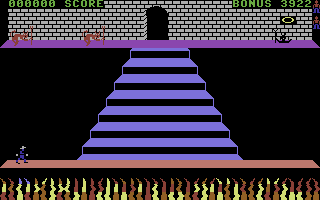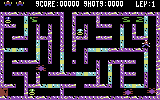Interview with Dave Lucas
Categoria: Interviste


There are many obscure games in the Commodore 64 softography. Many Software Houses were short-lived, lasting only a few months from rise to fall. So many stories about people and facts behind the early games are still untold. One of those games I fondly remember is Mr. Mephisto, and thanks to Mr. Dave Lucas we are going to unveil the whole story behind it!
At the bottom of the page you'll find a few selected scans of UK magazines with reviews of Mr. Mephisto. In the Museum area of this web site you'll find some production notes and sketches for the game.
Hello Dave, would you care to tell us something about yourself to break the ice?
My name is David Lucas (prefer to be called Dave) and I did the programming for the game. I find it hard to believe that after all these years people still remember it! For the records my full name is David I. Lucas, with my middle name being Ian.
Mr. Mephisto was first released on the Euro-Byte label in 1984 but Euro-Byte actually went "bust" a few months after the game was released. This meant that not many copies of this game were sold under Euro-Byte and we didn't make much money either, but also, due to the company going bust, I couldn't do anything with the game, and the copyright was eventually passed to a company in Southampton who then re-released the game on the Bug-Byte label about a year or two later.
When the game was originally released in 1984, the reviews for the game in magazines were good, but when it was released two years later, things had moved on so much that the same magazines reviewed the game again and gave it a poor rating.
Nowadays, I am still a computer programmer, but rather than games, I have been writing business software for both Windows (using C++), and also for the IBM mainframe and iSeries computers.
Taking another step back in time, what were your experiences with computers before doing business with Euro-Byte?
Back in 1984, I was an electronics engineer and got interested in computers when a relative of mine bought a Sinclair ZX81 computer. I was fascinated by it and very soon afterwards, bought my very first computer - a Commodore Vic20. I wanted to learn how to program it, so I started to attend a BASIC programming course at my local college. It was here that I met Graham Hunt and we very quickly became good friends. We gave up the course after about three lessons because we taught ourselves far more quickly than the college could.
Having a Vic20, our first project together was to design a simple switch that plugged into the expansion port of the Vic20 or Commodore 64. If you wrote a program in BASIC on the Vic20 or the Commodore 64 and ran the program before saving it, the program could crash, locking up your computer. When this happened, the only action available was to switch the computer off, so you would lose the code you had written. Our switch simply 'reset' the computer to restore it to it's initial start up state, but leaving the program which caused the crash in memory. We then provided a piece of software on tape which loaded directly into the computer 'stack' memory (this was the ONLY area of memory which never moved when for example a memory expansion was added). The program would run immediately after loading and would reset the necessary program pointers, so that you could now see and save the code that you had written that without this switch, would have been lost.
By this time, I had bought a new computer - a Commodore 64. I also bought a book on 6502 machine code programming. I read the book, and decided that as I loved the game of Pac-man, but could not at that time buy a version for the Commodore 64, I decided to write one for myself. I decided my version would be different from the the original and so I wrote the game so that as you attempted to clear the screen by eating the 'dots', the ghosts in my version would 'lay' them back down again. You had to work out how to stop the ghosts from 'laying' the dots back down in order to clear the level.
This game took me a month to write and when completed, I took it into my local computer shop in Fleet, Hampshire in the UK. I knew the people running the store, and I loaded it onto computers in the shop for people to play and test for me. It was here, that I met Shamus, (I hope I spelt his name correctly) from a company called Euro-Byte, who saw the game and offered to buy it from me. Shamus was afraid of copyright issues, so he asked me to change the name of the game to 'Grab-a-Crab' and to replace the ghosts with Crabs. I was happy to do this, as he had just bought the game off me, but as I had to change the graphics very quickly, I was not able to animate the Crabs properly in the time that I had. I was a bit disappointed with the result so I requested that my name was not credited to the game on the packaging.
Shamus encouraged me to write another game for Euro-Byte, and I came to an agreement with Graham that if he did the graphics, I would do all the 6502 programming. The result of this, was that Euro-Byte gave both Graham and myself new commodore 64 computers and also disk drives to encourage us. Platform games were all the rage at the time, and this gave me the idea of a moving staircase. Graham then came up with the idea of having demons on the stairs and somehow between us, we came up with the idea of Mr. Mephisto.
Let's talk a bit more about Grab-a-Crab. Where did you get the inspiration for the gameplay of this Pac-Man clone with some twists?
You are right, Grab-a-Crab is a version of Pac-man with a twist and as I have said, I love Pac-man games. I wrote this game, but didn't want to do a straight Pac-man copy which is why I changed the way the game played. Although I have played Grab-a-Crab recently I have only really played the first level, and just for 'nostalgic' reasons.
If I remember correctly, the first level plays just like normal Pac-man. On the next level, as you eat the pills, one of the Crabs goes round the screen replacing the pills. The idea, is that you have to eat one of the special pills and then, whilst the Crab is running away back to the centre of the screen you have to catch it (or eat it). This will stop the Crab replacing the pills and allow you to clear the screen of all the pills. On the next level, two Crabs will go around replacing the pills, so you must 'eat' both these Crabs before you can clear the screen. On the next level, three Crabs replace the pills...
And so on, you get the picture. Not really sure how I thought of this, I just wanted to make the game different.
By the way, for your information, Grab-a-Crab was advertised on British TV over the Christmas period in 1983 - I still have a copy of this advert on VHS tape (although not a particularly good copy).
Talking about Mr. Mephisto, it would be interesting to understand the story behind the game. In the beginning we see a movie theatre, therefore we're left wondering what's our role as the player: do we play as the viewer of a movie, or truly as the main character?
Mr. Mephisto was a man who while alive, sold his soul to the Devil but when he died, changed his mind and did not want to go to Hell. Our game was supposed to take up the story after Mr. Mephisto had died. The moving staircase carries those who are turned away from the gates of Heaven and takes them straight to Hell. After selling his soul, Mr. Mephisto is taken straight to Hell when he dies, and now his only way to Heaven is via the moving staircase with all the Demons trying to catch him and return him back to Hell.
As for the intro screen, well that is easy. The cinema was advertising the film of Mr. Mephisto and when you entered the game, you were playing the leading role in the film, trying to get to Heaven. It was also decided that I would do the graphics on this intro screen, and as you can tell, I cannot draw! Drawing the outside of a cinema seemed the easiest thing for me to do!


I was under the impression that Mr. Mephisto was the name of the demon in the end of the game, not our main character! Concerning this, I noticed that the review of the game published on "Which Micro and Software Review", as well as Graham Hunt, refer to our character as "Hugo".
As for the name Hugo, well this was Shamus' idea. To me, the hero in the game was always Mr. Mephisto and the big Demon on the last level was meant to be the Devil himself. The idea was that after escaping all the Demons on the early levels, the Devil was the final Demon to try to stop Mr. Mephisto from reaching Heaven.
Shamus came up with the 'story' about Hugo, and as far as I was concerned, he was the one marketing the game and so I happily let him produce his story line about Hugo. I hope this doesn't ruin your enjoyment of the game!
Quite the contrary, I'm satisfied that we have unveiled the mystery. So, there's a "clash" between the official background story and the one as first conceived by you! Moving on to the technical aspects, could you tell me something about the methods that were used in programming Mr. Mephisto?
Mr. Mephisto took Graham and myself three months to write. The main reason was the graphics for the stairway which took a good couple of weeks to first draw, and then write a piece of code which allowed the stairs to be drawn in any place on any screen, and the Commodore 64 would automatically make the stairway move. There was no such thing as a 'graphics engine' in those days! By the way, the stairway and the flames (at the foot of each level) were drawn by myself, Graham drew all the Demons and characters.
I used a program which I called a 'machine code monitor' to write these games. This allowed you to type a command (e.g. LDA #10) and the byte value for this would be 'poked' directly into the computer memory. To save the code, the entire area of memory would then be written out to disk.
Was a floppy disk version of Mr. Mephisto ever released?
Mr. Mephisto was never released on floppy, although I do still have a version on floppy from when I wrote the code - in fact, I believe I have a version of the game on Floppy with the Led Zeppelin 'Stairway to Heaven' music on it. I Cannot be certain of this, because although I know I have the floppy disks, they have been in a box in the garage for about 25 years and I do not have a Commodore 64 any more (mine went faulty many, many years ago). I believe I also have my notes about the game in the garage somewhere, including the drawings I made when trying to move the stairway.
Let's talk a bit more about the magazine reviews. During 1986, the budget version of the game, released under the Bug-Byte label, was reviewed by Zzap!64, which gave it a poor rating, disregarding the fact that the game had been created two years earlier, and the world of Commodore 64 games had changed in many ways in two years. What other magazines reviewed the game?
In 1984, the game was reviewed in these magazines: Commodore computing (September 1984 issue), Your Commodore (October 1984 issue), Personal Computer Games (August 1984 issue), Commodore Horizons (September 1984 issue) and Which Micro and software review (August 1984 issue). The last one (Which Micro magazine) also gave copies of the game away as a competition prize in the August 1984 issue. I have copies of all these magazines, but I didn't keep any from the 1986 re-release because they were not good!
After alle these years, are you still in touch with Jeremy Hall (Music), Graham Hunt (Graphics) or Shamus?
I haven't seen Graham for about 18 years, but he has always kept in touch with my ex Wife and I have found out only tonight that I may meet up with him this Saturday. My Son is to be married this Saturday and I am told that Graham has been invited to the Wedding. I understand Graham is not too well at the moment, but as long as he is well enough to attend, I will meet up with him again.
Regarding Jeremy, Shamus got in contact with Jeremy, but neither myself nor Graham knew him very well. He was though, very clever with music on the commodore 64. As I said before initially Mr. Mephisto had the Led Zeppelin music of 'Stairway to Heaven' which was brilliantly coded by Jeremy and I thought made the game sound great, however when we asked for permission, Led Zeppelin would not allow us to use their music in the game. We had to remove it and Jeremy quickly replaced the track with the music you now hear on the intro screen.
I haven't seen Jeremy since 1984. But Graham and I stayed friends for some years after until I went through a divorce from my Wife in about 1989. I moved closer to my work, and Graham and I rarely saw each other after this. The reason why we didn't write another game, was because I wanted to change my career to become a professional computer programmer and this took up too much of my time. Another reason was that I felt I was too old to write computer games - In 1984 I was 26 years old, and all the other game programmers I met at the time were still teenagers. I was offered a job as a games programmer after writing Mr. Mephisto, but I turned it down.
Shamus ran Euro-Byte from their office in Godalming, Surrey which was about 12 miles from where I lived. Shamus did a great job of marketing the Mr. Mephisto game, but unfortunately, after the initial orders for the game were despatched, Euro-Byte ran into cash flow problems and they went out of business. The copyright of the game was passed to a company in Southampton. I cannot remember the Company name, but they must have sold it on to Bug-Byte.
I have not seen him since. Shamus was a really nice guy, but I know he was very upset when Euro-Byte when bust and he felt really guilty because he was certain that if this had not happened, the game would have made myself and Graham (and of course Euro-Byte) a lot of money. Because of this guilt, I believe he went back to Ireland (where he came from) and I never saw or spoke to him again.
A very expensive advertising agency in London (Saatchi & Saatchi) were employed to market the Mr. Mephisto game and they had someone do the painting which was used for the 1984 (original) cassette front cover artwork. This painting was amazing, and it was promised to me, but unfortunately, I believe Euro-Byte went bust owing this company some money, so I never received the original painting.
Dave, that was the last question. Any final words for the Commodore 64 addicts out there?
The only thing I might like to add, was how lucky I feel I am to have been able to write computer games all those years ago. In 'those' days, the average person with a home computer could learn to program, release a game and possibly make some money, whereas for some years now, it has not been easy to compete with the large business's who have put large teams of people (and money) into writing games.
Having said that, with mobile devices like the Apple iPod Touch, and the iPad, I believe that for anybody interested, it is possible again (for a few years at least) for an individual to write
and sell their own games.
Trust me, the satisfaction you can get from writing your own game, however good or bad, far excels any excitement you can get from playing someone else's game - in my opinion anyway!
Reviews from Magazines
Commodore Computing (September 1984 issue)
Rating
Graphics: 



Sound: 



Playability: 



Comment
"Mr. Mephisto is original, works very well and is worth adding to your arcade collection."
Your Commodore (October 1984 issue)
Rating





Comment
"It's a must for any computer game enthusiast who thinks he or she can play games well. It is well worth the money and you will be writing to Euro-Byte for more clues when you can't figure it out"
Personal Computer Games (August 1984 issue)
Rating
Graphics: 6
Sound: 7
Originality: 7
Lasting Interest: 7
Overall: 7
Comment
"Mr. Mephisto is an intriguing and compulsive game. It is pitched at just the right level of difficulty to make you swat without ever actually inducing despair about reaching your goal"
Commodore Horizons (September 1984 issue)
Comment
"Mr. Mephisto is one of those games that is maddeningly addictive, and one that deserve consideration for a place in you own software library."
Which Micro and Software Review (August 1984 issue)
Rating


Comment
"Another in the gender of arcade/adventure then, owing much more to arcades than adventures. Nice one."
Zzap!64 (May 1986 issue)
Rating
Presentation: 72%
Graphics: 29%
Sound: 38%
Hookability: 23%
Lastability: 20%
Value for Money: 31%
Overall: 24%
Zzap! (May 1986 issue)
Rating
same as Zzap!64 (translation)
Euro-Byte
Euro-Byte Limited
Churchmill House
Ockford Road
Godalming
Surrey GU7 IQY
Games from Euro-Byte: Grab-a-Crab (1983), Dr. Pimples Dog (1983), Games Designer (1983), Mind Warp (1983), G-Force (1984), Mr. Mephisto (1984), Plop (1983), Chain Reaction (1983)
# - postato da AndreaP - 29 November 2010 [18:42]
# - postato da SevenLegion - 29 November 2010 [20:01]
# - postato da ABS - 30 November 2010 [11:06]



















